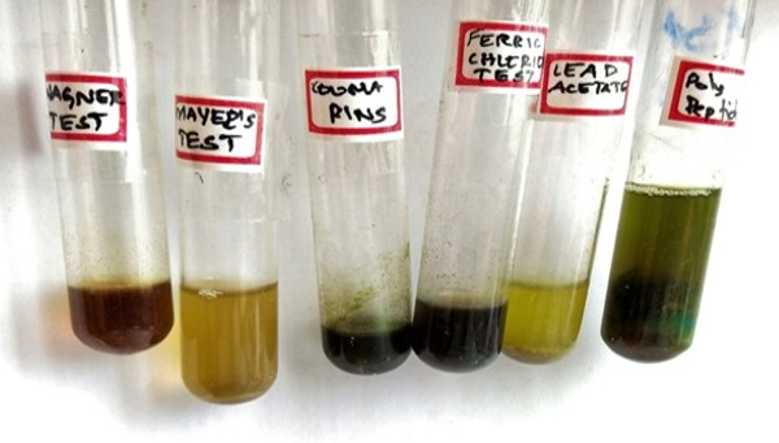Abstract
Melochia corchorifolia belongs to the Sterculiaceae family and is a common weed distributed throughout tropical and subtropical regions in many countries. Melochia corchorifolia is a medicinal plant which is used as a traditional folk medicine for the treatment of the various diseases. Several studies have reported antibacterial, antifungal, cytotoxicity effects and anti-cancer activity of water and methanol extracts of the leaf. The dried leaves were powdered and extracted with ethanol solvent through the Soxhlet apparatus. The phytochemical analysis was done using standard techniques on the ethanolic extract. The analysis showed the presence of various phytoconstituents such as flavonoids, alkaloids, steroids, terpenoids, glycosides, tannins, phenols, saponins and anthraquinones. Besides, the research was aimed at assessing the Anthelmintic behaviour of ethanol extract of Melochia corchorifolia leaves against Eisenia fetida ( Indian earthworms) the result shown that 300 mg/ml proved to be very active by paralyzing and killing the earthworms in a shorter time and followed by Antidiabetic activity in inhibition assay for α-amylase activity was evaluated using Melochia corchorifolia leaves showed maximum inhibition of the enzyme with the highest value of 85.0% seen at 100mg/ml. Our results reveal that ethanol extract of the leaf of Melochia corchorifolia acquires potent bioactive phytocompounds that might be developed into novel Anthelmintic and Antidiabetic activities.
Full text article
References
Ajaib, M., Khan, Z., Khan, N., Wahab, M. 2010. Ethnobotanical studies on useful shrubs of district. Pak. J. Bot, 42(3):1407–1415.
Alhakmani, F., Kumar, S., Khan, S. A. 2013a. Estimation of total phenolic content, in–vitro antioxidant and anti–inflammatory activity of flowers of Moringa oleifera. Asian Pacific Journal of Tropical Biomedicine, 3(8):623–627.
Alhakmani, F., Kumar, S., Khan, S. A. 2013b. Estimation of total phenolic content, in–vitro antioxidant and anti–inflammatory activity of flowers of Moringa oleifera. Asian Pacific Journal of Tropical Biomedicine, 3(8):623–627.
Amar, Z., Labib, S. N., Noureddine, G., Salah, R. 2012. Phytochemical screening of five Algerian plants and the assessment of the antibacterial activity of two Euphorbia guyoniana extracts. Der Pharmacia Lettre, 4(5):1438–1444.
Chandra, S., Khan, S., Avula, B., Lata, H., Yang, M. H., Elsohly, M. A., Khan, I. A. 2014. Assessment of total phenolic and flavonoid content, antioxidant properties, and yield of aeroponically and conventionally grown leafy vegetables and fruit crops: A comparative study. Evidence-based complementary and alternative medicine, 2014.
Cowan, M. M. 1999. Plant products as antimicrobial agents. Clin Microbiol Rev, 12(4):564–82.
Harborne, J. B. 1984. Methods of plant analysis. In In Phytochemical methods , pages 1–36, Dordrecht. Springer.
Heidari, R., Zareae, S., Heidarizadeh, M. 2005. Extraction, Purification, and Inhibitory Effect of Alpha Amylase Inhibitor from Wheat (Triticum aestivum Var. Zarrin). Pakistan Journal of Nutrition, 4(2):101–105.
Hullatti, K., Telagari, M. 2015. In-vitro α-amylase and α-glucosidase inhibitory activity of Adiantum caudatum Linn. and Celosia argentea Linn. extracts and fractions. Indian Journal of Pharmacology, 47(4):425–425.
Kazeem, M. I., Adamson, J. O., Ogunwande, I. A. 2013. Modes of inhibition of α-amylase and α-glucosidase by aqueous extract of Morinda lucida Benth leaf. BioMed research international, 2013:527–570.
Mamatha, B. S., Gnanasekaran, P. M. N., Senthilkumar, D., Tamizmani, G. P., Corchorifolia, T. M. 2018. Melochia Corchorifolia: A Review. World Journal of Pharmaceutical Research, 7(19):482–491.
Palaksha, M. N., Ravishankar, K., Sastry, V. 2013. Evaluation of in vitro antibacterial and anthelmintic activities of Melochia corchorifolia plant extracts. International Journal of Biological & Pharmaceutical Research, 4(8):577–581.
Patel, A. V., Patel, A. V., Bharadiya, P. D., Patel, N. M. 2011. A Study on Evaluation of Anthelmintic Activity of Leaves Extract of Tephrosea purpurea (Linn). Inventi Rapid: Ethnopharmacology, 3(5).
Pieroni, A. 2000. Medicinal plants and food medicines in the folk traditions of the upper Lucca Province, Italy. Journal of Ethnopharmacology, 70(3):235–273.
Prashanth, D., Padmaja, R., Samiulla, D. S. 2001. Effect of certain plant extracts on α-amylase activity. Fitoterapia, 72(2):179–181.
Pullaiah, T. 2014. Ethnobotany, Phytochemistry And Pharmacology Of Melochia Corchorifolia L. International Research Journal of Pharmacy, 5(7):543– 545.
Ramamurthy, V., Sathiyadevi, M. 2017. Preliminary Phytochemical Screening of Methanol Extract of Indigotera trita Linn. Journal of Plant Biochemistry & Physiology, 05(02):1–3.
Rao, P. R., Nammi, S., Raju, A. D. V. 2002. Studies on the antimicrobial activity of Heliotropium indicum Linn. Journal of Natural Remedies, 2(2):195–198.
Soares, L., Silva, L., Pezzini, B. 2015. Spectrophotometric determination of the total flavonoid content in Ocimum basilicum L. (Lamiaceae) leaves. Pharmacognosy Magazine, 11(41):96–96.
Wickramaratne, M. N., Punchihewa, J. C., Wickramaratne, D. B. M. 2016. In-vitro alpha amylase inhibitory activity of the leaf extracts of Adenanthera pavonina. BMC Complementary and Alternative Medicine, 16:466–466.
Authors

This work is licensed under a Creative Commons Attribution-NonCommercial-NoDerivatives 4.0 International License.

